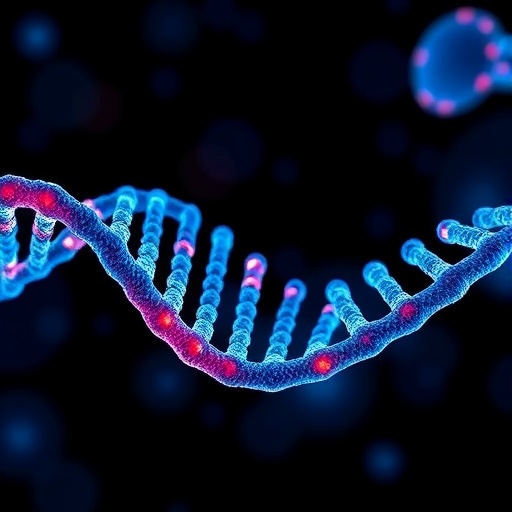In the intricate world of cellular biology, every step of gene expression is a finely tuned event critical to life. Among these, the nuclear export of messenger RNA (mRNA) stands as a pivotal process bridging the transcription of genetic information in the nucleus and the subsequent production of proteins in the cytoplasm. Despite significant progress over recent years in understanding how mRNAs are initially packaged into messenger ribonucleoprotein complexes (mRNPs), the nuanced mechanisms guiding these mRNPs from the nucleus out into the cytoplasm have remained largely opaque. However, groundbreaking research published in Nature by Hohmann and colleagues in 2025 sheds light on this essential step with unprecedented molecular detail, revealing an ATP-dependent molecular switch that orchestrates human mRNA export.
Traditionally, the formation and export of mRNPs have been viewed as sequential yet somewhat disconnected phases. The initial packaging of RNA strands by proteins to form mRNPs, especially involving the transcription-export (TREX) complexes, ensures that the mRNA is protected and marked for export. However, the transition of mRNPs from these nuclear environments to the nuclear pore complexes (NPCs), their docking at NPCs, and ultimate egress into the cytoplasm, had eluded comprehensive biochemical or structural elucidation. The new findings not only fill this gap but also propose a cohesive, ATP-gated regulatory model, positioning the DEAD-box helicase DDX39/UAP56 at the center of these transitions.
The researchers employed a combination of advanced biochemistry, structural biology techniques, and single-molecule assays to map the molecular choreography that defines mRNA export. One of the most striking revelations is how DDX39, an ATPase, functions as a molecular switch that toggles between different binding states controlled by its ATP-binding and hydrolysis cycle. This action effectively remodels the interaction networks of mRNPs, facilitating their disassembly from the nucleoplasmic TREX complexes and their subsequent engagement with the NPC-anchored TREX-2 complexes. This switch ensures that only properly processed and export-competent mRNPs reach the nuclear pores, reflecting a quality control checkpoint critical for cellular function.
The study delves deeply into the structural basis for this switch by resolving cryo-EM structures that capture DDX39 at different stages in the ATP cycle. These snapshots illustrate conformational changes that modulate the helicase’s affinity for mRNA molecules, altering how it interfaces with other proteins in the mRNP. Such latent control mechanisms were hypothesized but had never before been visualized with such clarity. This structural insight explains how the energy derived from ATP hydrolysis orchestrates the dynamic remodeling of mRNPs, a process pivotal to their export readiness.
Further, the data delineate the role of TREX and TREX-2 as distinct yet interconnected platforms in the mRNA export pathway. TREX complexes, residing in the nucleoplasm, initially bind mRNPs, packaging and preparing them. Once remodeled by DDX39 in its ATP-bound state, mRNPs are handed off to TREX-2 complexes anchored at the NPC. TREX-2 acts as a gateway facilitator, docking these cargoes precisely for transit through the nuclear pore channels. This handoff marks a critical transition point, reinforcing the idea that mRNA export is not a passive diffusion event, but a highly regulated, stepwise process governed by specialized molecular machineries.
An intriguing aspect of the research is the evolutionary conservation of this pathway. By comparing sequence motifs, biochemical behaviors, and the structural architecture of DDX39 and TREX components across species, the authors suggest a widely shared export mechanism in eukaryotes. This finding underscores the fundamental importance of the ATP-gated molecular switch not just in human cells but across the eukaryotic domain, offering a unifying framework that could explain mRNA export in organisms from yeast to humans.
In addition to its fundamental biological insights, this mechanistic elucidation has broader implications. Deregulation of mRNA export is implicated in various human diseases, including cancer and neurodegenerative disorders. Understanding this ATP-gated switching machinery at a molecular level offers new avenues for therapeutic intervention, potentially allowing the design of small molecules to modulate mRNA export selectively. Such interventions could rectify pathological export dysregulation or target virus-host interactions that exploit the host mRNA export pathways.
Moreover, the study opens exciting questions about coordination between transcription, mRNA processing, and export. The ATP-gated switch could serve as a nexus integrating multiple regulatory signals, ensuring that only fully processed, export-competent transcripts exit the nucleus. This integration might be closely linked with RNA surveillance mechanisms that prevent defective or improperly processed mRNAs from reaching the cytoplasm, thereby safeguarding protein synthesis fidelity.
The team’s comprehensive approach also sheds light on the dynamics at the nuclear pore complex, long considered a passive channel. Instead, the NPC emerges as an active participant in mRNP remodeling and quality control, aided by multiplex TREX-2 interactions. This contributes to a paradigm shift, viewing the NPC as an essential regulatory hub modulating gene expression post-transcriptionally.
One cannot overlook the technical sophistication underpinning this research. The combination of structural cryo-electron microscopy, ATPase activity assays, fluorescence anisotropy, and cross-linking mass spectrometry provides a multidimensional view of the molecular events that constitute mRNP export. This integrative methodology sets a new standard for investigating complex, dynamic ribonucleoprotein assemblies in the cell nucleus.
Furthermore, the elucidation of ATPase-driven conformational cycles in DDX39 adds to a growing body of literature situating energy-dependent enzymes at the heart of RNA metabolism. It underscores the elegant economy of cellular systems where nucleotide binding and hydrolysis cycles power directional chaperoning, remodeling, and processing of nucleic acid-protein complexes essential to life processes.
Collectively, this groundbreaking study propels our comprehension of mRNA export from a descriptive phase to a mechanistic era. It also fuels anticipation for future research exploring how this ATP-gated switch interfaces with other gene expression regulators and responds to cellular signals and stress. The detailed mechanistic framework bears potential to inspire new investigations into disease mechanisms linked to mRNA export anomalies and to the development of novel molecular tools for gene expression modulation.
Hohmann et al.’s work thus stands as a landmark achievement, elucidating a vital yet elusive aspect of gene expression. By revealing the molecular switch governing mRNA export, it illuminates an essential cellular journey from the nucleus to the cytoplasm—an odyssey powered by ATP and orchestrated by finely tuned molecular choreography. This discovery not only enhances fundamental biological understanding but also lays the groundwork for innovative strategies targeting mRNA export pathways in medicine and biotechnology.
Subject of Research: Molecular mechanisms of human messenger RNA (mRNA) export from the nucleus, focusing on the role of the ATPase DDX39/UAP56 and TREX/TREX-2 complexes.
Article Title: An ATP-gated molecular switch orchestrates human messenger RNA export.
Article References:
Hohmann, U., Graf, M., Tirián, L. et al. An ATP-gated molecular switch orchestrates human messenger RNA export. Nature (2025). https://doi.org/10.1038/s41586-025-09832-z
Image Credits: AI Generated
Tags: ATP-dependent molecular switchbiochemical elucidation of mRNPscellular biology breakthroughsgene expression regulationhuman mRNA transport mechanismsmessenger ribonucleoprotein complexesmolecular detail in mRNA transportmRNA export mechanismsnuclear export of mRNAnuclear pore complexes dockingRNA packaging processestranscription-export complexes





